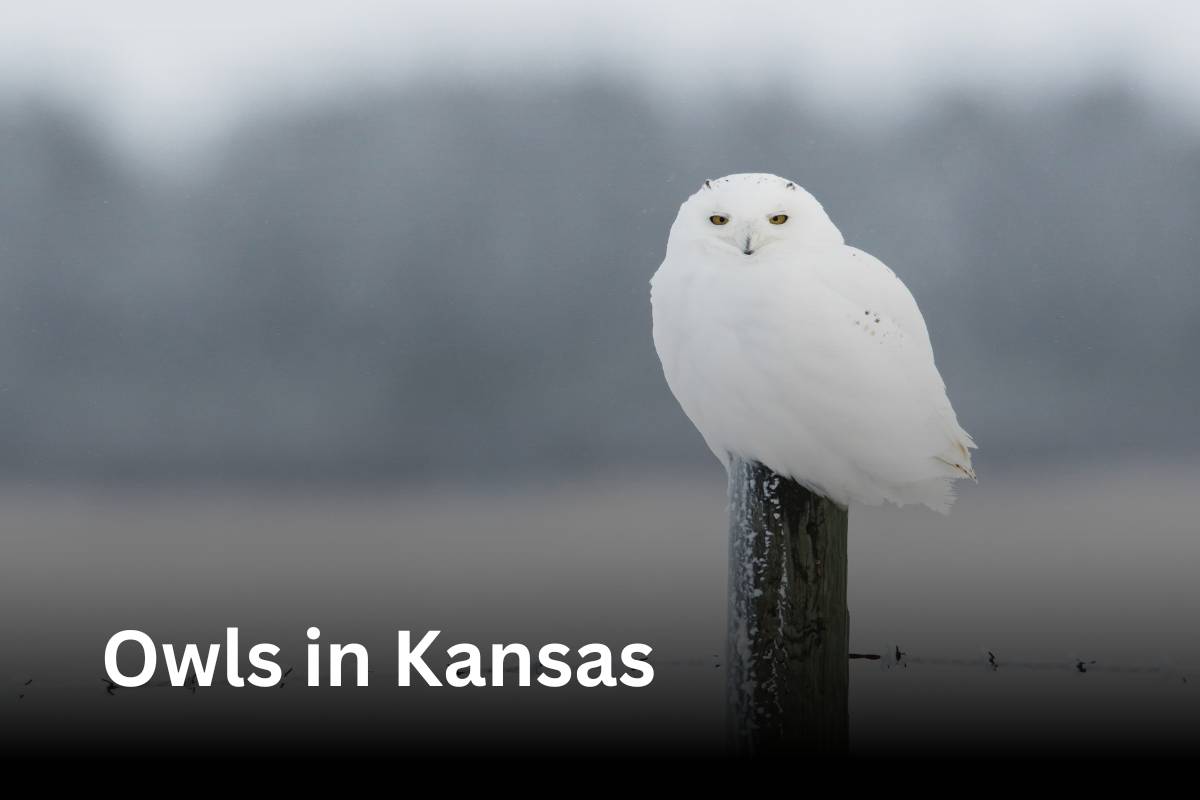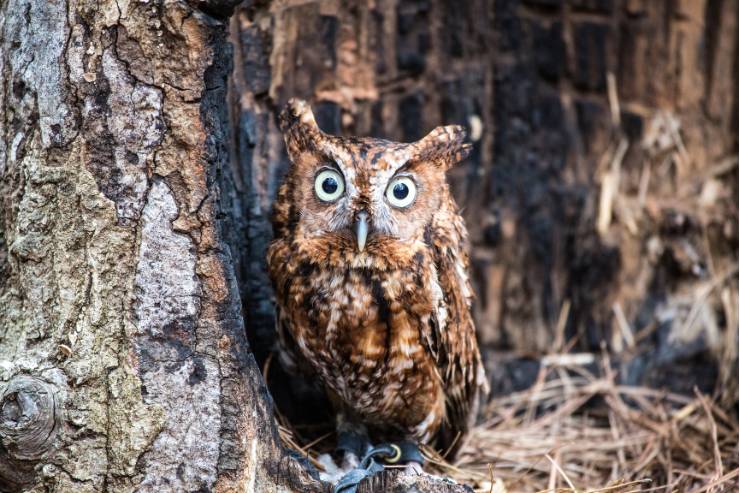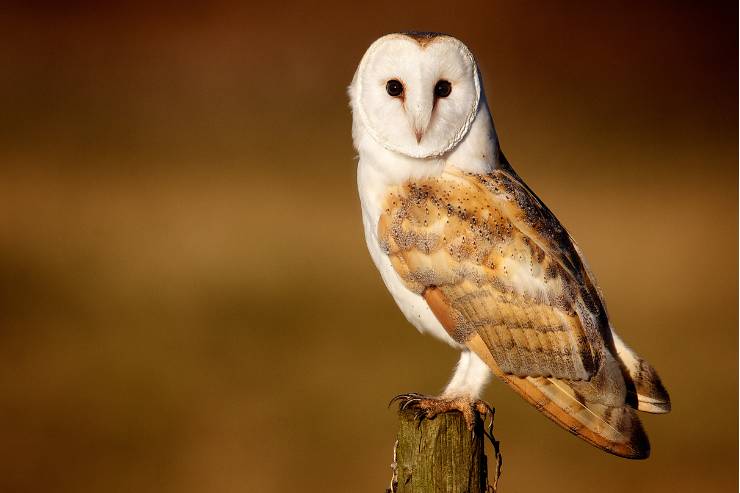Owls in Kansas

Kansas is a landlocked state in the Midwestern region of the United States. It is a very popular state for bird watching as it has a very highly recorded 483 bird species.
Also, several species of owl are found in Kansas with unique characteristics and feeding habitats. Some of them are all-year-round residents who can be found in parks and even near suburban areas, whereas others are rarer to spot.
So, keep on reading this article, to learn more about the most common owls that are found in Kansas and what makes every species special.
List of owls in Kansas:
- Great horned owl
- Barred owl
- Snowy owl
- Long-eared owl
- Western screech owl
- Barn owl
1. Great horned owl (Bubo virginianus)
The great horned owl, commonly known as the tiger owl or the hoot owl, is a large owl native to the Americas. This bird is an extremely adaptable bird with a vast range and is the most widely distributed true owl in the Americas.
It is a round-faced bird with a distinctive horn-shaped feather tuft on the crown of its head, which is darker than the rest of its head, promoting the overall camouflage.

The great horned owl possesses powerful, solid legs, feet, and claws. It has binocular vision due to its eyes, facing forward. Also, the eyes of the owl are various shades of yellow. It can also be distinguished by the white colored patch on its throat.
Brown and black stripes extend all over the white underbelly. In addition, the bill of the bird is black, surrounded by white or tan colored plumage. The feather on their back is darker, covered with brown and black markings.
Size and wingspan of Great Horned owl:
- Size: 46-63 cm (18.1-24.8 inches)
- Weight: 910-2500g (32.1-88.2 oz)
- Wingspan: 101-145 cm (39.8-57.1 inches)
- Life span: 20–30 years
Habitat: It is one of the most common owls in North America and is found year-round throughout Kansas.
This species habitat is widespread, but during breeding season they prefer places with good nesting sites in trees instead of open grassland.
Feeding: The great horned owls mostly feed on rabbits and rodents, but they may also hunt larger animals, occasionally up to two times their size.
Also, it is one of the earliest nesting birds in North America, often laying eggs weeks or even months before other raptorial birds.
Likewise, in poor lighting conditions, they are capable of seeing about 35 times better than humans. Whereas humans have seven neck bones, these species have 14 neck bones, which allow them to turn their heads up to 270 degrees.
2. Barred owl (Strix varia)
The barred owl, scientifically known as Strix varia, is a North American large species of owl. It is also known as a northern barred owl and a striped owl.
This bird is a large nocturnal bird, probably best known for their unique vocalizations that carry well over 0.8 km(0.5 mi). They are mottled brown and white overall, with dark brown, almost black eyes.

Also, the underparts are mainly marked with vertical brown bars on a white background, but the upper breast is crossed with horizontal brown bars. The tail and wings are barred brown and white.
Size and wingspan of Barred owl:
- Size: 43-50 cm (16.9-19.7 inches)
- Weight: 470-1050g (16.6-37.0 oz)
- Wingspan: 99-110 cm (39.0-43.3 inches)
- Life span: up to 10 years (in the wild), over 20 years (in captivity)
Habitat: The barred owls like to nest in dense forested areas, and for this reason are found mostly in the far eastern parts of Kansas.
Additionally, it is found throughout most of the eastern United States, as well as much of southern Canada and Mexico.
Feeding: They are carnivorous birds. They feed mostly on small mammals but also prey on birds, amphibians, and sometimes fish and reptiles.
3. Snowy owl (Bubo scandiacus)
The snowy owl, also recognized as the polar owl, the white owl, and the Arctic owl, is a large, white owl of the true owl family.
Snowy owls are white birds with varying amounts of black or brown markings on the body and wings. It has smooth rounded heads that rarely show ear tufts.

Also, the body is bulky, with dense feathering on the legs that makes the owl look wide at the base when sitting on the ground. Their eyes are yellow.
Size and wingspan of Snowy owl:
- Size: 52-71 cm (20.5-27.9 inches)
- Weight: 1600-2950 g(56.4-104.1 oz)
- Wingspan: 126-145 cm (49.6-57.1 inches)
- Life span: 10 years or more (in the wild) and 28 years(in captivity)
Habitat: This species is rare in Kansas. Their range is typically north up into Canada and the Arctic Circle, but sometimes, they will have an irruptive migration, coming down south in large numbers.
During winter, look for these birds along shorelines of lakes and oceans, as well as on agricultural fields and airport lands. It breeds in the treeless arctic tundra.
Feeding: It eats a variety of food including lemmings, Arctic hares, mice, ducks, and seabirds. While, females remain with the young, males bring the food, and then females feed it to the owlets.
4. Long-eared owl (Asio otus)
The long-eared owl is also known as the northern long-eared owl, lesser horned owl, or cat owl because of their catlike facial features. It is a medium-sized species of owl, that belongs to the genus Asio.
These birds are fairly dark birds with buff or orange faces and intricate black, brown, and buff patterning on their feathers.

Additionally, the long-earned owl ear tufts are black with buff or orange fringes, the face has two vertical white lines between the eyes, and the eyes are yellow.
Size and wingspan of Long-eared owl:
- Size: 35-40 cm (13.8-15.8 inches)
- Weight: 220-435 g (7.8-15.3 oz)
- Wingspan: 90-100 cm (35.4-39.4 inches)
- Life span: 25–30 years
Habitat: It is one of the most widely distributed and most numerous owl species in the world.
However, they are not very common in Kansas, but some spend winter there and are spotted from September to May. They fly further north during their breeding season.
It prefers open landscapes with groups of trees, hedges, or small woods, as well as pastureland with rows of trees and bushes.
Feeding: The long-eared owl’s breed are carnivorous specialized predators. They focus their diet almost entirely on small rodents, especially voles, which often compose most of their diet.
They also eat various small mammals, small birds, small snakes, lizards, and insects.
5. Western screech owl (Megascops kennicottii)
The western screech owl is a small owl that is a permanent resident of the northwest region of North and Central America. Also, it is closely related to the eastern screech owl.
It has a round head with ear tufts, yellow eyes, and a yellowish bill. All have either brown or dark gray plumage with streaking on the upper parts.
Also, the tail is short, and no red morph. While female western screech owls are larger than males. Their physical appearance is quite similar to whiskered and eastern screech owls, so it is best to identify them by their calls.

Size and wingspan of Western screech owl:
- Size: 19-25 cm (7.5-9.8 inches)
- Weight: 100-305 g (3.5-10.8 oz)
- Wingspan: 55-62 cm (21.6-24.4 inches)
- Life span: 1–8 years
Habitat: The western screech owl are an accidental species in Kansas. They have only been spotted a few times in the southwest of the state.
Their habitat includes temperate forests, subtropical and tropical montane forests, deserts, and even suburban parks and gardens.
Feeding: This bird mainly consumes small mammals such as rats, birds, and large insects. Although, they are opportunistic predators and can even take small trout at night.
Western screech owls have also been known to hunt Mallard ducks and cottontail rabbits, sometimes.
6. Barn owl (Tyto alba)
The barn owl is a medium-sized owl and belongs to the family Tytonidae. It is larger than a screech-owl but smaller than a Great horned owl.
Also, it is a pale-colored bird with dark eyes. It has long, rounded wings and short tails, which combine with a buoyant, loping flight to give it a distinctive flight style. Also, the legs are long, and the head is smoothly rounded, without ear tufts.
The barn owls have a mix of buff and gray on the head, back, and upper wings, and are white on the face, underwings, and body. When seen at night, it can appear all white.

Size and wingspan of Barn owl:
- Size: 32-40 cm (12.6–15.8 inches)
- Weight: 400-700 g (14.1-24.7 oz)
- Wingspan: 100-125 cm (39.4-49.2 inches)
- Life span: up to 4 years
Habitat: The barn owls are year-round residents in the state of Kansas and also the most widespread landbird species in the world, occurring on every continent except Antarctica.
They prefer living close to water sources, as prey tends to be more plentiful. Despite their worldwide distribution, they are declining in some areas due to habitat loss.
Feeding: The barn owls mostly prey on terrestrial but bats and birds are also taken as well as lizards, insects, and amphibians.
Conclusion
Kansas is undoubtedly a great place for owls to live, and the state provides all they need with its beautiful woodland areas, abundant trees, and more.
Owls are mysterious and captivating creatures, and each species has its unique charm. If you are lucky, you might spot one of these enchanting birds in your own backyard!

